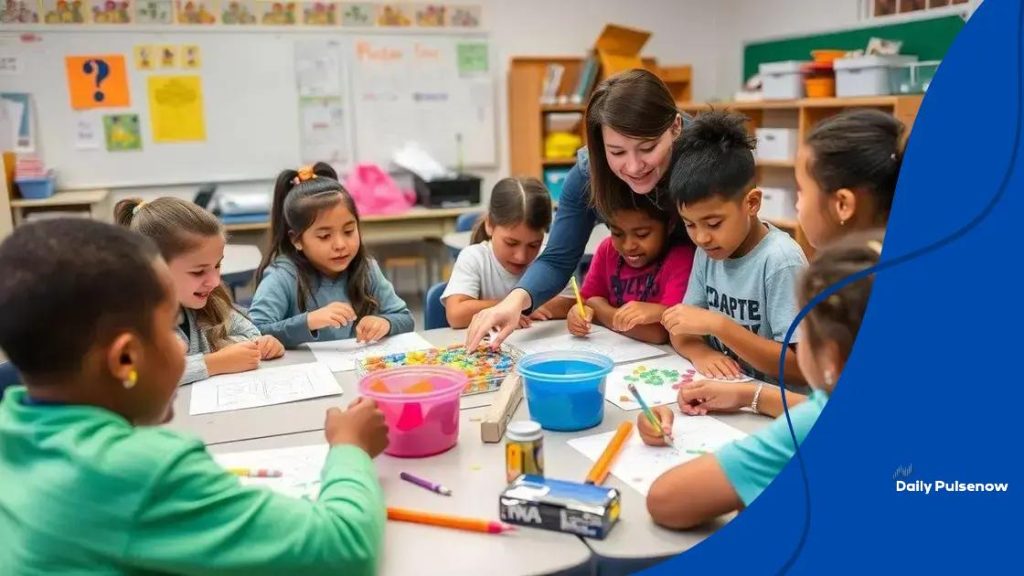Gamification in education: boost engagement and retention

Anúncios
Gamification in education enhances student engagement and retention by incorporating game elements, motivating learners through rewards, competition, and interactive experiences, while also allowing for measurable assessment of its effectiveness.
Gamification in education is transforming how students engage with learning materials. Have you ever wondered how game-like elements can improve motivation? Let’s explore this fascinating topic.
Anúncios
Understanding gamification in education
Understanding gamification in education is essential for teachers and educators. It’s about applying game design elements in non-game contexts to boost learning outcomes. By integrating these elements, educators can create a more engaging and interactive learning environment. This approach not only captures students’ attention but also holds it, making learning enjoyable and effective.
What is Gamification?
At its core, gamification involves using game mechanics in educational settings. Teachers can incorporate points, badges, or leaderboards to motivate students. This method transforms traditional learning into an interactive experience. Students become active participants rather than passive learners.
Key Elements of Gamification
- Points: Assigning points for completing tasks encourages competition and achievement.
- Badges: Badges reward students for milestones, promoting a sense of accomplishment.
- Leaderboards: Displaying rankings can drive motivation and friendly competition among students.
Implementing gamification can be straightforward. Start by selecting appropriate game elements that align with your educational goals. Remember, the focus should be on enhancing students’ experiences and not merely on competition. Gamification works best when it fosters collaboration and intrinsic motivation.
Anúncios
Furthermore, a well-designed gamified experience allows students to fail safely and learn from their mistakes. This trial-and-error approach encourages growth. As they navigate through challenges, students develop resilience. This mindset is vital in education and life.
Using gamification also appeals to students’ diverse learning styles. Interactive elements can help visual learners grasp concepts. Meanwhile, auditory learners engage through discussions and feedback. Kinesthetic learners benefit from hands-on activities related to gamified tasks.
Key benefits of gamification for learners
The key benefits of gamification for learners are numerous and transformative. By implementing game-like elements in educational settings, students experience enhanced engagement and motivation. This can lead to better retention of information and a more enjoyable learning process.
Increased Engagement
One of the most significant advantages of gamification is its ability to capture learners’ attention. When lessons incorporate fun challenges or competitions, students show increased interest. They become active participants instead of passive receivers of information. This active involvement encourages deeper learning as students invest emotionally in their education.
Motivation and Achievement
- Intrinsic Motivation: Gamification fosters a love for learning by making it enjoyable.
- Goal Setting: Students set achievable goals, pushing them to strive for success.
- Immediate Feedback: Instant feedback helps keep students focused and informed about their progress.
Moreover, gamifying learning activities allows students to experience a sense of accomplishment. Achievements and rewards boost their confidence. This positive reinforcement encourages them to take on new challenges and develop a growth mindset.
Additionally, the collaborative aspects of gamification create opportunities for teamwork. Students work together in groups, learning to communicate and solve problems as a unit. This not only enhances their social skills but also prepares them for real-world scenarios.
As they navigate through gamified lessons, students build resilience and adaptability. They learn that failure is a part of the learning process and that persistence is key. Such experiences prepare them for future academic and life challenges.
Strategies for successful gamification

Implementing successful gamification strategies in education can change how students learn. Educators need to focus on specific techniques that capture attention and promote engagement. By understanding the best methods, teachers can foster a more interactive and effective classroom experience.
Define Clear Objectives
Setting clear learning objectives is crucial. When students know what they are working towards, they stay focused and motivated. This clarity helps them understand the purpose behind gamified activities. It’s essential to align game mechanics with educational goals to ensure effectiveness.
Incorporate Feedback
- Immediate Feedback: Provide students with instant feedback on their performance. This allows them to reflect on their progress and adjust their strategies.
- Encouragement: Use positive reinforcement. Celebrate achievements to motivate students to strive for more.
- Peer Reviews: Encourage students to give feedback to each other. This can foster collaboration and build community.
Additionally, integrating elements that allow for both competition and cooperation can enhance the learning environment. Gamified activities should create opportunities for teamwork while still promoting individual growth. Students can work together on challenges while also tracking their personal progress against goals.
Using technology effectively is another strategy for successful gamification. Tools like learning management systems and educational apps can facilitate gamified experiences. They offer metrics to help educators monitor progress and adjust strategies based on data. Educators can also create online leaderboards to display students’ achievements, fostering friendly competition.
It’s also vital to keep things fresh and engaging. Regular updates to the gamified elements can maintain interest. Rotating challenges or introducing new rewards can motivate students continuously. By ensuring variety in tasks and challenges, teachers can keep students engaged and hungry for knowledge.
Challenges in implementing gamification
Implementing gamification in educational settings comes with its own set of challenges. While the benefits are significant, recognizing potential obstacles is crucial for successful implementation. Educators and administrators need to navigate these hurdles to create effective gamified environments.
Technological Limitations
One significant challenge is the availability of technology. Not all schools have access to the necessary equipment or software. This disparity can create unequal learning opportunities among students.
Resistance to Change
- Instructor Hesitation: Some teachers may be reluctant to adopt new methods. They might feel more comfortable with traditional teaching styles.
- Student Adaptability: Students may initially struggle with new formats, preferring the familiarity of traditional classes.
- Parental Concerns: Parents might worry about the effectiveness of gamified methods, questioning whether they promote learning adequately.
Furthermore, aligning gamification with curriculum standards can be challenging. Educators must ensure that gamified activities meet educational goals while being engaging. Balancing fun and learning is essential to maintain academic integrity.
Another challenge is designing appropriately challenging tasks. Gamification should motivate students without overwhelming them. Creating tasks that are too easy may lead to boredom, while overly complex tasks can cause frustration. Striking the right balance is key.
Assessing the effectiveness of gamification can also be tricky. Educators must find reliable ways to measure engagement and learning outcomes. Traditional assessment methods may not accurately reflect the impact of gamified elements.
Measuring the impact of gamification
Measuring the impact of gamification in education is essential to understand its effectiveness. Educators need to track various indicators to assess how well gamified elements enhance learning experiences. Without clear measurements, it’s challenging to determine whether the implementation is beneficial.
Engagement Metrics
One of the first areas to evaluate is student engagement. Metrics such as attendance rates and participation levels in gamified activities provide insights into student interest. Higher engagement often correlates with better learning outcomes, making it crucial to monitor how many students actively participate.
Assessment of Learning Outcomes
- Test Scores: Comparing test scores before and after gamified lessons can highlight improvements in knowledge retention.
- Project Completion: Tracking how many students complete projects or tasks tied to gamification gives a clear view of motivation.
- Self-Assessment: Encouraging students to reflect on their learning can reveal how they perceive their understanding and progress.
Another important aspect to consider is feedback from students. Collecting input on their experiences can provide valuable qualitative data. Students may express how gamification affects their motivation and enjoyment of learning, giving teachers deeper insights into its impact.
Utilizing technology to gather and analyze data is also effective. Many learning management systems offer analytics tools that track student behavior. By reviewing these analytics, educators can identify trends that inform future gamification strategies.
Finally, conducting surveys and focus groups can be beneficial. These methods allow students to express their thoughts and feelings about gamified activities. Understanding their perspectives helps teachers refine their approaches and maximize the impact of gamification in the classroom.
FAQ – Frequently Asked Questions about Gamification in Education
What is gamification in education?
Gamification in education involves using game design elements to enhance learning experiences, making them more engaging and interactive.
How can gamification improve student engagement?
By incorporating game mechanics like points and rewards, gamification captures students’ interest and motivates them to participate actively in their learning.
What challenges are faced when implementing gamification?
Challenges include technological limitations, resistance to change from educators and students, and aligning gamified activities with educational standards.
How can I measure the impact of gamification in my classroom?
You can measure the impact by tracking engagement metrics, assessing learning outcomes, collecting student feedback, and analyzing performance data.





